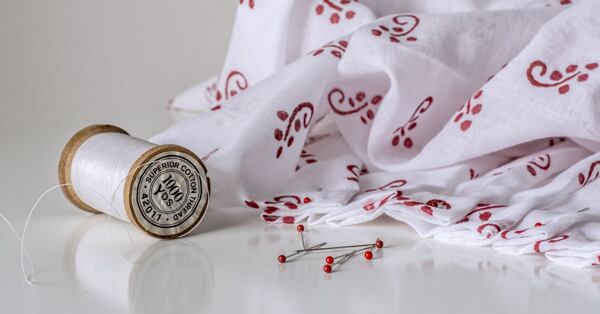
what is empire fashion?
What are we talking about when we talk about Empire fashion? First off, pronounce it the French way (ahm-PEER) – after all it was Napoleon Bonaparte who put the “empire” into your Empire waistline. The trend covers the period 1800 to 1815 when Napoleon lorded it over France as First Consul and then as Emperor. With its clear visual references to ancient Greece and Rome, the style actually resuscitated an earlier flirt with antiquity under Louis XIV, Neoclassism, which has experienced a number of revivals aside from the Empire period.
From its birthplace in France, the Empire look spread like wildfire across Europe and hopped the pond to North America. It finally petered out around 1815, making way for Regency fashion in England, the Biedermeier in Central Europe, and the Late Empire or Restoration styles in France itself.
empire fashions on the silver screen
One quick and dirty way to conjure up a sense of Empire fashion is to look at the numerous costume dramas set in this period. And there are plenty – the era is popular among filmmakers. Here are a few productions where Empire fashion plays a leading role.
- Bridgerton – It’s probably no surprise that this Netflix series, plays fast and loose with period fashion – while the Bridgerton dresses do have the Empire silhouette, there are some fabulous liberties taken with colors, fabrics, and other details (no bonnets!)
More authentic depictions of period dressing can be found elsewhere. For example, most films based on the work of Jane Austen (1775–1817) do a good job.
- Emma (both the 1996 and 2020 versions)
- Pride and Prejudice (1995 and 2005)
- Sense and Sensibility (1995)
There are also Empire costumes in
- Mansfield Park (1994)
- Vanity Fair (2004)
empire, regency, directoire
To see the Empire style in context, it may be useful to review the other styles of the early nineteenth century. Here’s a cheat sheet.
Rococo till 1789 – Imagine the royal court just prior to the French Revolution in 1789 – powdered wigs, baubles, extra-wide skirts, and stylized makeup. This period is sometimes called Late Baroque, especially in Central Europe where it never reached quite the wild extremes it did in France. The opulent Rococo period went out with a bang with the storming of the Bastille in 1789.
Directoire 1793-1799 – This is the brief period when France was governed by the new, revolutionary government, the Directory. It stretches from 1793 (the executions of Louis XVI and Marie Antoinette) through 1799. Fashion being, as ever, deeply political, people dressed to show political and class affiliation. The look held on to some Rococo elements but was much subdued
Empire 1800-1815 – The Empire period covers the Consulate and the First French Empire. Napoleon established a dictatorship in all but name as First Consul and then declared himself Emperor in 1804. He styled himself after the Roman emperors and the look suffused everything in this period from architecture to ladies’ gowns. The Empire period ended with France’s defeat at Waterloo and the Congress of Vienna, where the great powers divvied up Europe after the Napoleonic wars
Regency 1811–1820 – Specific to Britain, the Regency period covers the years when George IV ruled as Prince Regent (mental illness made George III unfit to lead the country in his final years). Regency fashion dovetails with late Empire style. It’s what we picture when we think of Jane Austen’s England. (We’d also like to give a Sartorial nod here to the incredible Zack Pinsent, who has recently sparked renewed interest in this period, not only by teaching himself to sew these styles, but by wearing absolutely nothing else!)
Georgian 1714-1830 and Victorian 1837-1901 – Also specific to Britain, these periods are named after the rulers of the time. The Georgian period covers the back-to-back reigns of kings George I through IV. The Empire period falls into the latter Georgian era. Queen Victoria reigned from 1837–1901, and a range of styles came and went while she was on the throne
Restoration 1815-1830 – The period in French fashion that spans the short-lived return of the Bourbons to the French throne. This roughly coincides with the Biedermeier period in Austria and Central Europe. The Restoration ended with a revolution that established a constitutional monarchy, followed by yet another in 1848, a time of unrest throughout Europe, with people in the streets in Britain, Germany, Hungary, and Bohemia
the empire look
The first whispers of Empire style were already stirring at the time of Marie Antoinette. Herself a symbol of the playful, gaudy Rococo, she was known to disappear off to her country estate occasionally, where she tended to wear looser, casual gowns.
After the French Revolution, fashion experienced a sea change. Gowns retained their narrow waistlines and broad skirts but were less ornate, and new elements began to appear, such as bodices inspired by the gentlemen’s Redingote (an overcoat with a double row of buttons).

Around 1790, a strong classical trend hit the fashion world. There wasn’t a niche of cultural life that Antiquity didn’t reach – architecture, painting, interior decor. Europe began to import large quantities of fine cotton fabrics from India that were just perfect for making simple, flowing dresses, a style known as á la chemise, from the French word for a shift, which they very much resembled. The new style, which looked an awful lot like the things women had worn beneath their gowns just the year before, were a nod to the simple gowns of ancient Greece and Rome that people knew from classical sculptures.
Chemise gowns were of simple construction, little more than a shift made of cotton muslin and tied just below the bust with a ribbon. Some had a more finished bodice that ended just below the bustline in a straight or slightly flared skirt. Sleeves were worn short and slightly shirred, puffed, or ruffled.
These white gowns could be lightly decorated with embroidery, lace, or ribbons in white or a pale color. Seamstresses used a very light touch so as not to disrupt the simplicity of the dress. Women wore nothing underneath, or at the most a flimsy knitted shift.
Those who weren’t comfortable in the chemise style, opted for more conservative gowns and wore an undershirt, a bodice like a soft corset, or a simple straight slip

Some refused to dress in the new fashion entirely, sticking with older styles. This tendency is well depicted in the mentioned Netflix production Bridgerton, where some characters dress in pre-revolutionary styles while others sport the trendier Empire silhouette. Whatever you may think of the authenticity of the series, this historical situation is one point that the creators nailed
The chemise craze lost steam around 1810 and once again people started to wear colors, heavier fabrics, and more ornamentation. The neckline rose and scarves and collars covered cleavage. There’s no doubt that the European winter weather played its part. The “muslin plague” – diseases like pneumonia and kidney inflammation that could be traced to overexposure in inadequate clothing – claimed the lives of more than one fashionista who ventured out on a frosty day in a featherweight gown.
Portrait of Madame Charles Maurice de Talleyrand Périgord, 1804. The lady is wearing a white two-layered gown with a brief, low-cut bodice and tiny, shirred sleeves. The only decorations are a gold ribbon and some light needlework at the lower hem of the underlayer. A broad shawl with an embroidered edge, probably imported from India, lies on the chair. The interior has some Neoclassical details – amphora-like vases and other knickknacks. Photo: Wikimedia Commons
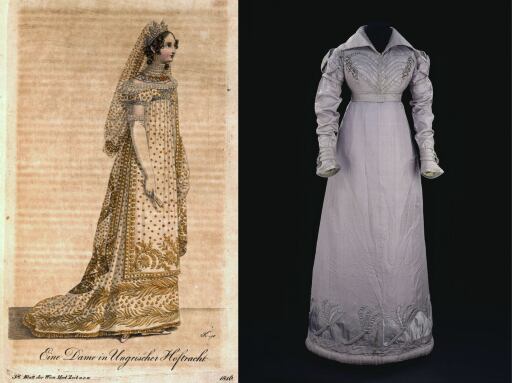
Ladies did their best to keep themselves warm with large shawls and stoles made of imported cashmere or locally produced cotton or wool, short Spencer jackets, long narrow Redingote coats, or broad capes.
(pic. 1.) Richly embroidered Hungarian court dress, 1816. The underdress is satin and the outer layer is made of petinet (a fine mesh) embroidered with gold thread. The caption recommends velvet and moiré as other suitable materials. Photo: Wiener Zeitschrift magazine, 1816
(pic. 2) Gown with Spencer jacket made between 1817 and 1820. The short Spencer jacket is made to look as if it is the bodice of the gown but is actually separate. The dress is made of silk. Note the padded lower hem, a common element in this period. © Victoria and Albert Museum, London
Towards the end of the Empire period, fashion began to trend towards the Biedermeier look that succeeded it. The tiny puff sleeves began to gain in volume and the waistline slowly approached the midriff.
fabrics used in the empire dress
Empire gowns were sewn from all available materials, but the most popular were lightweight cottons, linens, and silks. Featherweight fabrics like batiste, lawn, and muslin, were popular for day dresses and evening gowns alike. They were either imported from India (in which case they were of cotton) or produced in Europe from imported cotton or local linen.

After Napoleon’s coronation in 1804, heavier materials began to stage a comeback – damask, satin, velvet, wool. While the reasons were largely economic (the muslin craze mainly benefitted importers while local production suffered), the harsh European climate also played a role, as did sheer vanity and the ultimately irresistible urge to strut one’s stuff in a killer dress made of some outrageously expensive, luxury fabric.
Empire fashions tended towards solid colors with a little embroidery or sewn-in detailing such as shirring or gathering. Gradually, simple patterns like stripes or dainty florals were introduced. Then, out of the blue, richly patterned fabrics not just on white but on colored backgrounds (red, blue, brown, black) hit the scene, with floral patterns and natural motifs the hands-down favorites.
(pic. 1) Sampler of silk fabrics with woven patterns from sometime between 1775 and 1800. The dainty patterns and muted colors are typical of the period. © Victoria and Albert Museum, London.
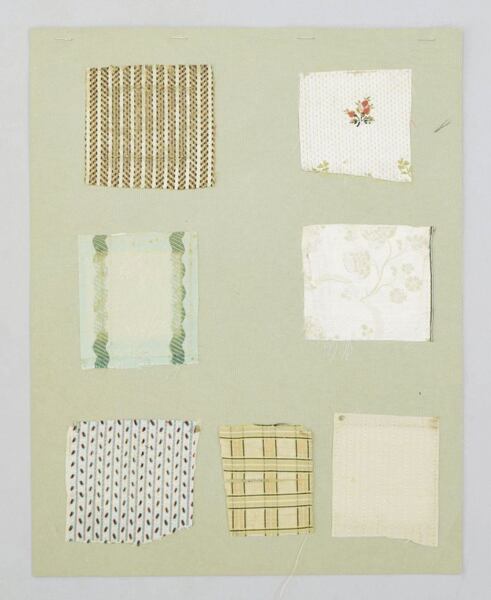
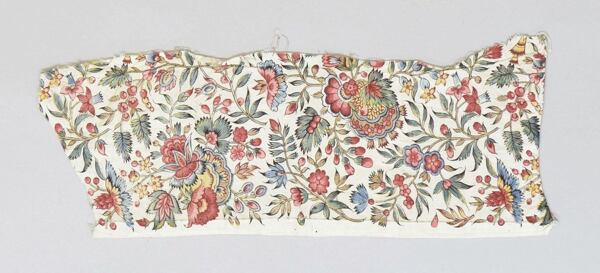
(pic. 2) Swatch of cotton dressmaker’s fabric made in England between 1780 and 1810. Printing technology was in its infancy, but some manufacturers were already producing full-color, premium-quality prints. © Victoria and Albert Museum, London.
shopping for empire style fabrics today
The Empire silhouette has survived the test of time and we still wear it today, though with some modifications (gowns of that period had an especially short-backed bodice and the skirt was gathered in the rear).
Cotton fabrics in Empire style florals are just about universal and can be used to sew more than just period costumes. We see them in summer dresses, blouses, tunics, and skirts, as well as home decor, pillowcases, and romantic curtains.
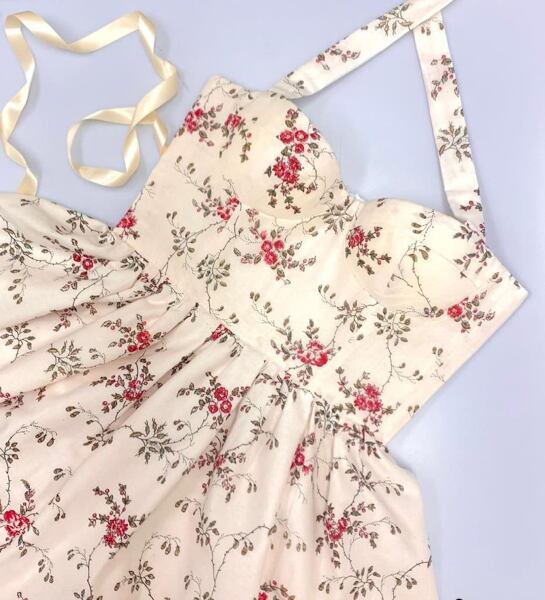
Do you wear the Empire look?
What do you think of Empire textile patterns and embroidery?
Share photos of your dresses and period costumes!


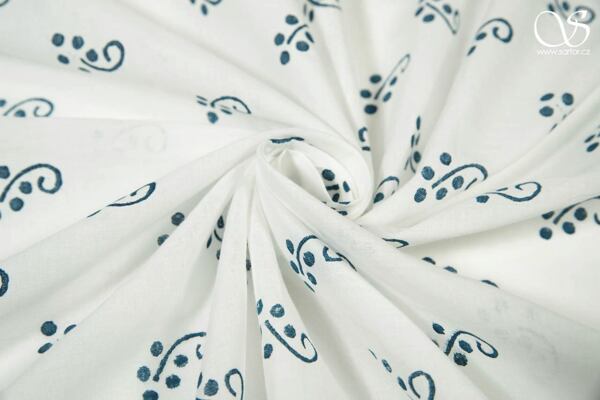
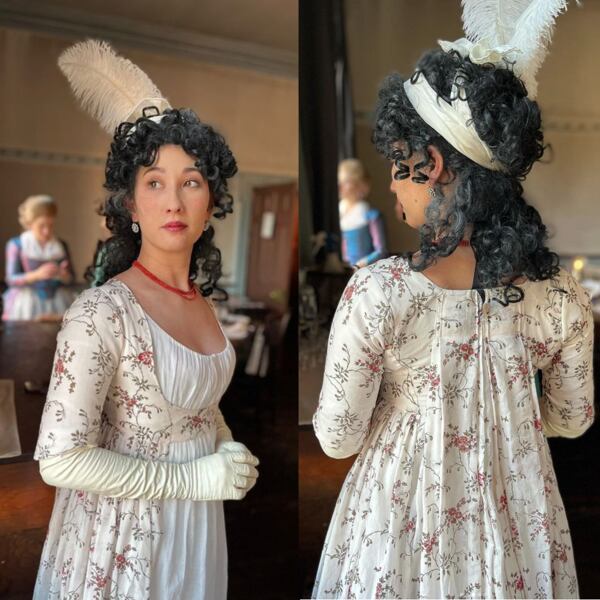




Comments(0)